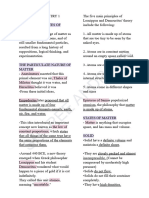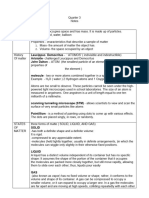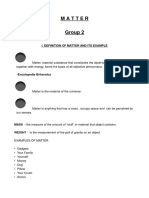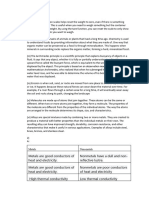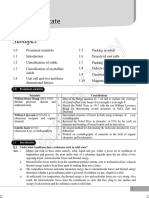0 ratings0% found this document useful (0 votes)
3 views4TH Lessons Science
4TH Lessons Science
Uploaded by
Kaliele de GuzmanSCIENCE MATTER
Copyright:
© All Rights Reserved
Available Formats
Download as PDF, TXT or read online from Scribd
4TH Lessons Science
4TH Lessons Science
Uploaded by
Kaliele de Guzman0 ratings0% found this document useful (0 votes)
3 views5 pagesSCIENCE MATTER
Original Title
4TH LESSONS SCIENCE
Copyright
© © All Rights Reserved
Available Formats
PDF, TXT or read online from Scribd
Share this document
Did you find this document useful?
Is this content inappropriate?
SCIENCE MATTER
Copyright:
© All Rights Reserved
Available Formats
Download as PDF, TXT or read online from Scribd
Download as pdf or txt
0 ratings0% found this document useful (0 votes)
3 views5 pages4TH Lessons Science
4TH Lessons Science
Uploaded by
Kaliele de GuzmanSCIENCE MATTER
Copyright:
© All Rights Reserved
Available Formats
Download as PDF, TXT or read online from Scribd
Download as pdf or txt
You are on page 1of 5
SCIENCE MATTER What are solids?
LESSON 4: states properties changes in matter
Properties of Solids
Solids have fixed shape and fixed volume. The attractive forces are strong making
Liquids have no fixed shape, but with a the particles to be much closer to one
fixed volume. another. Solids have definite shape and
Gasses have no fixed shape and no fixed volume. They are incompressible, rigid and
volume. compact. The particles are not free to move,
they have only vibrating motion.
Properties of Matter
1. Physical → properties of matter that can Types of Solids According to
be observed or measured without the matter
undergoing a change in composition. Attractive Forces
ex. odor, color, taste, size, shape, texture, 1. Molecular solids – solids that are
hardness, malleability, conductivity, ductility, composed mainly of nonmetallic elements
elasticity,melting point, boiling point, density (soft, brittle, not durable, easy to melt, easy
to burn)
2. Chemical → properties of matter that can - C N O F P S Cl Br I H He Ar Ne Kr
only be observed or measured when matter Ex. ice, wood, rice, candle, plastic, paper,
undergoes a change in composition sugar, foam, butter, rubber, skin
ex. flammability, toxicity, chemical reactivity,
drug effectivity 2. Metallic solids – solids composed of
metals
- Li Na Ca Mg Al Fe Mn Cu Zn Ag Au
Changes in Physical State
- alloys
1. Melting → from solid to liquid
(brass-Cu,Zn , bronze-Cu,Sn, steel, jewelries)
2. Evaporation → from liquid to gas
3. Sublimation → from solid to gas
3. Ionic solids – solids composed of metals
4. Freezing → from liquid to solid
and nonmetals
5. Condensation → from gas to liquid (NaCl – salt , rust – Fe2O3, sand, pebbles)
6. Deposition → from gas to solid
4. Covalent network solids – They are
All phase changes are accompanied by extremely hard. The atoms are strongly
change in temperature (loss or gain of bonded to one another.
heat). (ex. diamond, silica)
Kinds of Changes in Matter Types of Solids According to
1. Physical Change – This is a change in Particle Arrangement
the physical properties of matter
1. Crystalline → have a well-defined shape
(dimensions and state). The
because the particles are in a highly
identity/composition and properties of
ordered arrangement.
matter remain the same and there is no
ex. salts, metals, diamond, gemstones
formation of a new substance. Most are
reversible.
2. Amorphous → solids with particles in
disorganized arrangements
2. Chemical Change – Both the physical
Ex. Charcoal, rubber, foam, glass
and chemical properties of matter, as well
as its composition, change. It is always
Allotropes → substances composed of the
accompanied by formation of new
same element but with different
substances with new set of properties. Most
arrangement
are irreversible.
Ex. a. C – diamond, graphite, fullerene
b. O – oxygen gas, ozone gas
Properties of Liquids Kinetic Molecular Theory
1. The intermolecular (attractive) forces are 1. Gas particles are very small, have
stronger than gasses making the liquid negligible volume and are far apart from
particles to be closer to one another and each other.
have definite volume. 2. The intermolecular forces among gas
2. Liquids are also fluids. The particles particles are very weak.
are free to move around and slide past one 3. The gas particles are in constant and
another causing liquids to flow easily and chaotic motion.
have no fixed shape. 4. The average kinetic energy of particles is
Viscous → liquids that do not flow easily proportional to the absolute temperature.
like syrup, honey, glue, motor oil. 5. Gasses exert pressure through collisions
(with the walls of their container or with
3. Surface tension is defined as the force other particles).
on the surface of a liquid that makes the
surface area as small as possible. The L1: The Atom and the
surface molecules are pulled
Subatomic Particles
downward/inward making the surface of a
About Matter
liquid like a “thin, taut skin”.
Surface tension allows needles, razor
Leucippus of Miletus and Democritus
blades, small insects to float on water and of Abdera (500 B.C.)
the reason why droplets and bubbles are → Greek philosophers who believed that
round. matter is
composed of very small indivisible particles
4. Capillary action “refers to the rising or called “atoms.”
movement of a liquid to a narrow tube.” Plato ( 428 – 348 B.C.) and Aristotle
Cohesive force – attraction between like (384 – 322 B.C.)
particles → They did not believe in atoms; for them,
Adhesive force – attraction between unlike matter can
particles. be divided without limit. They also promoted
5. Evaporation or vaporization is the the “four element theory of matter”.
changing of liquid into gas. This process
becomes faster as the temperature
Modern Ideas About Matter
increases.
Robert Boyle (1627 -1691) → defined
Evaporation of sweat (induced by
element as any substance that cannot be
fanning) has a cooling effect.
broken down into a simpler substance.
Antoine Lavoisier (1743 – 1794)
Vapor pressure – the pressure exerted by
→ A French scientist who also said that
the vapor particles
elements are composed
Boiling point – the temperature in which
of atoms.
the atmospheric pressure is equal to the
→ He separated water into its component
vapor pressure inside a container
parts – hydrogen
and oxygen.
GASSES → He emphasized accuracy and
Atmosphere → the layer of gases that measurement in his experiments;
envelopes the Earth; supports life on Earth considered as the “Father of Modern
Composition of atmosphere: Chemistry”.
78% nitrogen (N2)
21% oxygen (O2) John Dalton (1766 – 1844) → an English
1% other gases like carbon dioxide, scientist who believed that matter is
water vapor, argon, helium, composed of tiny indestructible spheres
xenon, neon, krypton
(with mass) called atoms.
Dalton’s Atomic Theory Joseph John Thomson
1. Matter is composed of very small, • An English scientist who named the
indivisible, spherical particles called atoms. cathode rays as “electrons”.
2. All atoms of a given element are alike • discoverer of the electron
and have identical properties. But, they • suggested the plum pudding model or
differ from the atoms of the other elements. the raisin-bread model of the atom.
3. Atoms combine chemically with other
atoms to form compounds but remain Wilhelm Roentgen (1845-1923)
unchanged during ordinary chemical → discoverer of x-rays
reactions. Henri Becquerel (1852-1908)
4. Atoms can combine in simple numerical → a French physicist who discovered the
ratios like 1:1, 1:2, 2:3 and so on. natural radioactivity of certain substances.
Ernest Rutherford (1871-1957)
Electrical Nature of Matter → The British physicist who discovered the
Coulomb’s Law – states that bodies with 3 types of radiation (alpha, beta, gamma)
the same charge repel while bodies of → He performed the alpha – scattering
opposite charges attract experiment and discovered the nucleus.
→ Formulated by Charles Coulomb (1736 → He performed the gold foil experiment
– 1806), a French scientist to test the correctness of the plum pudding
Coulomb (C) – an electrical unit of charge model. He expected that the alpha particles
would easily pass through the gold foil with
ELECTRIC CHARGES very few slight deflections.
(+) (—)
Electron → the negatively charged particle
Objects with an equal amount of positive
discovered by J.J. Thomson
and negative charges are said to be
Proton → the positively charged particle
electrically neutral.
discovered by E. Rutherford
Neutron → the neutral particle discovered
FORCES BETWEEN CHARGES by James Chadwick (1891-1974)
• Objects with like charge repel
(+) (+) (+) (+)
Rutherford’s Nuclear Model
• Objects with opposite charge attract
→ The atom has a nucleus at its center
(+) (+) (—) (—) which is surrounded by electrons.
Matter is composed of very small electrically
charged particles. Atomic number (Z)
= no. of protons = no. of electrons
The Subatomic Particles Atomic Mass (A)
William Crookes (1832-1919) = no. of neutrons + no. of protons
→ an English chemist who discovered the ions → charged particles
“cathode rays” using the Crookes tube. cation → positive ions
anion → negative ions
Properties of Cathode Rays
• cathode rays consisted of subatomic isotopes → are atoms of the same element
particles coming having the same atomic number but with
from the cathode different atomic masses (differ in number of
• cathode rays travel in straight lines neutrons)
• cathode rays when hit something will Atomic number (Z)
cause it to = no. of protons = no. of electrons
shine brightly Atomic Mass (A)
• cathode rays are negatively charged = no. of neutrons + no. of protons
2. Energy sublevels → describe the
shapes of space where the electrons are
L2: The Atomic Theory moving s, p, d, f
3. Orbitals → the region of space occupied
Dalton’s spherical model of the atom –
by the electrons (angle / orientation)
atoms are like very small, indivisible and
indestructible spheres with mass.
Types of Energy Sublevel
1. s (spherical) → has only 1 orbital – 2
Joseph John Thomson (1856-1940) electrons
→ He proposed the plum pudding or 2. p (principal) → has 3 orbitals – 6
raisin-bread model of the atom. electrons
3. d (diffused) → has 5 orbitals – 10
Rutherford’s Nuclear Model of the Atom electrons
→ The atom is mostly an empty space 4. f (fundamental) → has 7 orbitals – 14
with negatively charged electrons
electrons orbiting a positively charged
*Each orbital can be occupied by a
nucleus. It is in the nucleus
maximum of two electrons.
where all the positive charges and the
mass of the atom is
Concentrated.
Electron Configuration
→ describes the arrangement or
distribution of electrons in an atom
Planetary Model of the Atom Rules to be followed:
→ suggested by Neils Bohr 1. Aufbau Principle → electrons occupy
(1885-1962) ; the nucleus the
is at the center of the atom surrounded available orbitals in order of increasing
by electrons energy.
that follow certain imaginary circular
orbits. 2. Hund’s Rule of Multiplicity →
(The atom is compared to the solar When electrons enter a sublevel with more
than one orbitals (p,d,f), electrons will
system.)
occupy first all the available orbitals with
their spins in the same direction before they
Quantum Mechanical Model pair up with another electron of opposite
→ the model of the atom proposed by spin.
Erwin
Schrodinger (1887-1961) and Werner 3. Pauli’s Exclusion Principle →
Heisenberg. two electrons occupying the same
→ the nucleus is surrounded by electron orbital must have opposite spins
clouds No two electrons in an atom can have
Quantum Model of the Atom the same set of quantum numbers.
→ the nucleus is surrounded by electron
clouds
Important Features of the
Quantum Model
1. Main energy levels → describe the total
energy of
the electrons (distance from nucleus)
1st, 2nd, 3rd, 4th, 5th, …
L3: DEVELOPMENT OF 2nd → with 8 elements → 2s1- 2p6
3rd → with 8 elements → 3s1 - 3p6
PERIODIC TABLE 4th → the first long period with 18 elements
Brief History → 4s1 - 3d1 - 10 - 4p6
1800 – 1849 → 24 new elements were 5th → another long period with 18 elements
discovered → 5s1 - 4d1 -10 - 5p6
Johann Wolfgang Dobereiner 6th → one of the longest period with 32
→ proposed the Law of Triads: The middle elements including the lanthanide series
element in the triad had an atomic weight → 6s1- 5d1-10- 4f1-14 - 6p6
that was the average of the other two
members. 7th → another longest period with 32
Ex. Li, Na, K Ca, Sr, Ba Cl, Br, I S, Se, Te elements including the actinide series
→ 7s1- 6d1-10- 5f1-14 - 7p
Law of Octaves → proposed by John Blocks → elements can be grouped into s,
Newlands; arranged the 62 p, d, f blocks
known elements in order of increasing
atomic weights, noted that after interval of B. Vertical Columns (18 Groups)
eight elements, similar physical and IUPAC → recommended the use of 1 – 18
chemical properties reappeared A & B → two groups of elements with
Roman or Arabic numerals (1A – 8A, 1B –
Dmitri Ivanovich Mendeleev → he 8B)
arranged the elements in order of increasing Representative Elements (A Group)
atomic weights and found apparent → s and p blocks elements
periodicity of properties. He left vacant Transition Elements (B Group)
spaces for new elements to be discovered. → d block elements
Inner Transition Elements
1900 – 1949 → the era of quantum → f block elements
mechanics, 13 new elements were
discovered Elements in the same period have the same
number of main energy levels while
Henry Moseley arranged the elements in elements in the same group have the same
increasing atomic numbers and found a
number of valence (outermost) electrons.
relationship between the elements’ x-ray
frequencies and their atomic numbers. He
summarized this by stating the modern periodic
law, “the properties of the elements are
periodic functions of their atomic numbers.”
The last major change to the periodic table
resulted from Glenn Seaborg's work in the
middle of the 20th century. Starting with
plutonium in 1940, Seaborg discovered Representative Elements
transuranium elements 94 to 102 and 1A → Alkali metals
reconfigured the periodic table by placing the
2A → Alkaline-earth metals
lanthanide and actinide series at the bottom of
3A → Boron group
the table. In 1951 Seaborg was awarded the
Nobel Prize in chemistry and element 106 was 4A → Carbon group
later named seaborgium (Sg) in his honor. 5A → Nitrogen group
6A → Oxygen group
Important Features of the Periodic 7A → Halogen group
8A → Noble gasses
Table
A. Horizontal Rows (7 Periods)
1st → the shortest period with only 2
elements
(H, He) → 1s1 - 1s2
You might also like
- General Chemistry NotesDocument7 pagesGeneral Chemistry Notesdeveravanessa01100% (1)
- Unit 5 Materials and Cycles On EarthDocument218 pagesUnit 5 Materials and Cycles On EarthBlop100% (1)
- Handout On Matter (2018)Document9 pagesHandout On Matter (2018)scientistgenerosoNo ratings yet
- General Chemistry 1 3Document12 pagesGeneral Chemistry 1 3shareeandradaNo ratings yet
- 1GP - Chemistry NotesDocument12 pages1GP - Chemistry NoteseriannenabazengNo ratings yet
- Science ReviewerDocument7 pagesScience ReviewerMARITHE ROJIANNE MERCADONo ratings yet
- Genchem NotesDocument10 pagesGenchem NotesjasminemuammilNo ratings yet
- Review of Chemistry ConceptsDocument15 pagesReview of Chemistry ConceptsAnele CatayasNo ratings yet
- 12 STM 005Document4 pages12 STM 005mavelmaxvelNo ratings yet
- Brown Aesthetic Group Project Presentation 20240207 082108 0000Document30 pagesBrown Aesthetic Group Project Presentation 20240207 082108 0000jillianaynemanaNo ratings yet
- General ChemistryDocument5 pagesGeneral ChemistryBon AshleeNo ratings yet
- ChemistryDocument32 pagesChemistryAndrei Angelo PantigNo ratings yet
- Science Reviewer Q3Document12 pagesScience Reviewer Q3Ayessah Ingrid AbeloNo ratings yet
- Matter 65Document13 pagesMatter 65Venkateswar PatroNo ratings yet
- NOTES NO. Quarter 3Document8 pagesNOTES NO. Quarter 3Nelly May AspanNo ratings yet
- Matter Group 2: I. Definition of Matter and Its ExampleDocument8 pagesMatter Group 2: I. Definition of Matter and Its ExampleMichael S LeysonNo ratings yet
- Gen ChemmotDocument4 pagesGen Chemmotgrishamcacal19No ratings yet
- Intermolecular ForcesDocument9 pagesIntermolecular Forces11-STEM 1 Penaso, Hannah Nicole V.No ratings yet
- CGENCHEMDocument7 pagesCGENCHEMwritingbecomesatherapyNo ratings yet
- Unit IiiDocument12 pagesUnit IiiIvy Marie ToyonganNo ratings yet
- Understanding MatterDocument3 pagesUnderstanding MatterAdrianne Rey A. CadanganNo ratings yet
- G10 Review ChemistryDocument2 pagesG10 Review ChemistryaintlykieNo ratings yet
- What Is MatterDocument7 pagesWhat Is MatterpinieraaurapaulaNo ratings yet
- 1st Semester Q1 General Chemistry (Notes)Document10 pages1st Semester Q1 General Chemistry (Notes)vince.resultay07No ratings yet
- Components of MatterDocument19 pagesComponents of MatterJerry PrestoNo ratings yet
- Us To Make Solids of Desired PurposeDocument5 pagesUs To Make Solids of Desired PurposeSam JonesNo ratings yet
- Lecture 1 Medical ChemistryDocument165 pagesLecture 1 Medical ChemistryCypher Soth ViNo ratings yet
- Chemistry 2 ReviewerDocument2 pagesChemistry 2 RevieweralicolipanoNo ratings yet
- Chapter 2 Matter and Its PropertiesDocument7 pagesChapter 2 Matter and Its PropertiesJennelyn BaylonNo ratings yet
- GEN CHEMISTRY 1 MODULE (Midterm)Document37 pagesGEN CHEMISTRY 1 MODULE (Midterm)Crisanta GanadoNo ratings yet
- GENERAL CHEMISTRY 1 - Lesson 1Document8 pagesGENERAL CHEMISTRY 1 - Lesson 1Fernandez, Nadine Kate T.No ratings yet
- MLS12101: Foundations of Chemistry 1. Matter and EnergyDocument15 pagesMLS12101: Foundations of Chemistry 1. Matter and EnergyfuckyouNo ratings yet
- 01 Handout 1Document3 pages01 Handout 1jade protacioNo ratings yet
- Module 1 Lesson 1Document60 pagesModule 1 Lesson 107 JAVIER LLYOD GENELSON B.No ratings yet
- Week 1: Kinetic Molecular Model of Liquids and SolidsDocument31 pagesWeek 1: Kinetic Molecular Model of Liquids and SolidsCrizza Mae CuregNo ratings yet
- Gen ChemDocument3 pagesGen ChemJanice RiliNo ratings yet
- Imelda B. Corpuz, RPH, MSPHDocument49 pagesImelda B. Corpuz, RPH, MSPHAdzrina AhmadNo ratings yet
- Full Chem TestDocument5 pagesFull Chem TestKomal SainiNo ratings yet
- Matter in Our Surroundings: S.NO. Topics Page NoDocument15 pagesMatter in Our Surroundings: S.NO. Topics Page NoDabbu ChaudhryNo ratings yet
- 3rd Quarter Science 8Document50 pages3rd Quarter Science 8John Ryan PiolNo ratings yet
- Chemistry CampusDocument63 pagesChemistry Campusishzc.11No ratings yet
- General Chemistry 2 Q3 Week 2Document2 pagesGeneral Chemistry 2 Q3 Week 2jcjimz259No ratings yet
- Chemistry Chapter 1Document41 pagesChemistry Chapter 1sonalitheshine1No ratings yet
- CBSE Class 9 Science Revision Notes Chapter - 1 Matter in Our SurroundingsDocument68 pagesCBSE Class 9 Science Revision Notes Chapter - 1 Matter in Our SurroundingsParesh RanjanNo ratings yet
- Building Blocks of MatterDocument20 pagesBuilding Blocks of MatterTi NeNo ratings yet
- Gen Chem NatennnDocument5 pagesGen Chem NatennnAriaane Grace DaquioagNo ratings yet
- 12th Science HSC Chemistry I PDFDocument14 pages12th Science HSC Chemistry I PDFSayyed SohelNo ratings yet
- Matter and It - S Properties Learning Material PDFDocument12 pagesMatter and It - S Properties Learning Material PDFikennahtNo ratings yet
- Chapter 2: Structure of The AtomDocument42 pagesChapter 2: Structure of The AtomThanabalan MunuswamyNo ratings yet
- Science REVIEWERDocument8 pagesScience REVIEWERJoannah PinoteNo ratings yet
- General Chemistry/Properties of Matter/Basic Properties of MatterDocument4 pagesGeneral Chemistry/Properties of Matter/Basic Properties of MatterrayestmNo ratings yet
- Matter and ITS Properties: Arvin C. Diamante Master Teacher II Nicolas L. Galvez Memorial NHS June 18, 2018Document57 pagesMatter and ITS Properties: Arvin C. Diamante Master Teacher II Nicolas L. Galvez Memorial NHS June 18, 2018Arvin Corpuz DiamanteNo ratings yet
- LP - GP - Coulomb's LawDocument9 pagesLP - GP - Coulomb's LawAllyza SobosoboNo ratings yet
- Folio Chemistry Form 4 Chapter 2Document34 pagesFolio Chemistry Form 4 Chapter 2Nurul Syafiqa MahadhirNo ratings yet
- Notes Chem Enely 1Document11 pagesNotes Chem Enely 1rickyNo ratings yet
- Lesson1 Properties of MatterDocument25 pagesLesson1 Properties of MatterwonyswiftNo ratings yet
- 3rd Quarter Science 8Document12 pages3rd Quarter Science 8RICHARD MACADINENo ratings yet
- Children Encyclopedia Chemistry: The World of KnowledgeFrom EverandChildren Encyclopedia Chemistry: The World of KnowledgeRating: 5 out of 5 stars5/5 (3)
- The Phases of Matter - Chemistry Book Grade 1 | Children's Chemistry BooksFrom EverandThe Phases of Matter - Chemistry Book Grade 1 | Children's Chemistry BooksNo ratings yet
- Physc 112Document21 pagesPhysc 112Jeff Dela RosaNo ratings yet
- History of Chemistry: Name: Vine D. OrtegaDocument8 pagesHistory of Chemistry: Name: Vine D. OrtegaVine OrtegaNo ratings yet
- The 10 Best Physicists PDFDocument5 pagesThe 10 Best Physicists PDFemNo ratings yet
- Chemistry The Science in Context Volume I and II 5th Edition Gilbert Test BankDocument36 pagesChemistry The Science in Context Volume I and II 5th Edition Gilbert Test Bankshute.scasely.i94b100% (37)
- CHEM 2101 Lecture 1 (Atomic Structure)Document4 pagesCHEM 2101 Lecture 1 (Atomic Structure)Asif UddinNo ratings yet
- Chapter 2: Atoms, Molecules, and IonsDocument16 pagesChapter 2: Atoms, Molecules, and IonsAbdelfattah Mohamed OufNo ratings yet
- Chemistry The Central Science 11th Edition Brown Test BankDocument75 pagesChemistry The Central Science 11th Edition Brown Test Bankmichellebrownodzabfqtkn100% (18)
- WS - Atom Webquest KEYDocument4 pagesWS - Atom Webquest KEYChristopher ShiehNo ratings yet
- TNPSC GSDocument1,172 pagesTNPSC GSYogakeerthigaNo ratings yet
- STD IX Chem ch-4 WorksheetDocument2 pagesSTD IX Chem ch-4 WorksheetRehan ZakariaNo ratings yet
- Physical-Science-Module 4 The Development of The Atomic StructureDocument23 pagesPhysical-Science-Module 4 The Development of The Atomic StructureJoana CastilloNo ratings yet
- CBSE Class 9 Science Revision Notes Chapter - 4 Structure of AtomDocument7 pagesCBSE Class 9 Science Revision Notes Chapter - 4 Structure of AtomShweta ShuklaNo ratings yet
- Nuclear Physics: Leaving Cert Physics Long Questions 2018 - 2002Document30 pagesNuclear Physics: Leaving Cert Physics Long Questions 2018 - 2002nimalranasinghe2505No ratings yet
- Module 3 General ChemistryDocument17 pagesModule 3 General ChemistryIan ParoneNo ratings yet
- Worksheet 1: History of Atom: Name: Date: Score: /20 Grade & Section: TeacherDocument4 pagesWorksheet 1: History of Atom: Name: Date: Score: /20 Grade & Section: TeacherSoleil PortugueseNo ratings yet
- Structure of Atom ProjectDocument21 pagesStructure of Atom ProjectJaisam JNo ratings yet
- Atomic StuctureDocument26 pagesAtomic StucturefatzyNo ratings yet
- 12Ch2 Atom ModelsDocument31 pages12Ch2 Atom ModelsSarah SaeedNo ratings yet
- In Search of The Atom: Chemistry, Grades 9-12Document11 pagesIn Search of The Atom: Chemistry, Grades 9-12Bing Sepe CulajaoNo ratings yet
- Chemistry TimelineDocument5 pagesChemistry TimelineLyncell Martin VillarNo ratings yet
- Atomic Models: Mr. Daniel Jiménez Ms. Catalina CruzDocument18 pagesAtomic Models: Mr. Daniel Jiménez Ms. Catalina CruzSantiago Coronado JiménezNo ratings yet
- Chemistry Notes Class 9Document72 pagesChemistry Notes Class 9Ayesha Zafar KhanNo ratings yet
- Worlds Top 10 Physicists of All Time PDFDocument15 pagesWorlds Top 10 Physicists of All Time PDFFadewNo ratings yet
- Atomic Theory WebQuestDocument92 pagesAtomic Theory WebQuestTamara Baez FloresNo ratings yet
- .... Lesson 3 - Background RadiationDocument12 pages.... Lesson 3 - Background RadiationMarcus WrightNo ratings yet
- Lesson 2.1 Models of The AtomDocument71 pagesLesson 2.1 Models of The AtomTristan PereyNo ratings yet
- Ernest Rutherford: (August 30, 1871 - October 19, 1937)Document4 pagesErnest Rutherford: (August 30, 1871 - October 19, 1937)johny BraveNo ratings yet
- Atomic PhysicsDocument5 pagesAtomic Physicslove meNo ratings yet
- Atoms QuizDocument6 pagesAtoms QuizThị Như Quỳnh HoàngNo ratings yet



